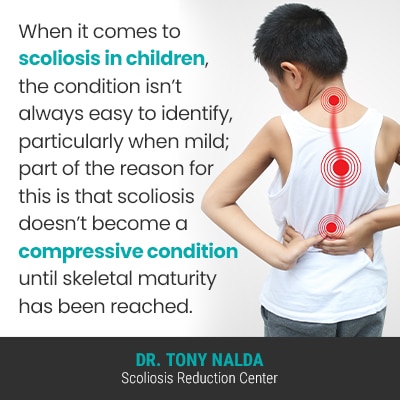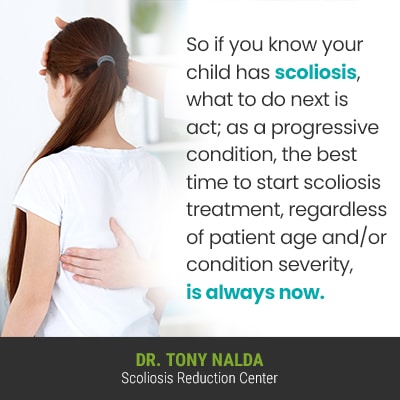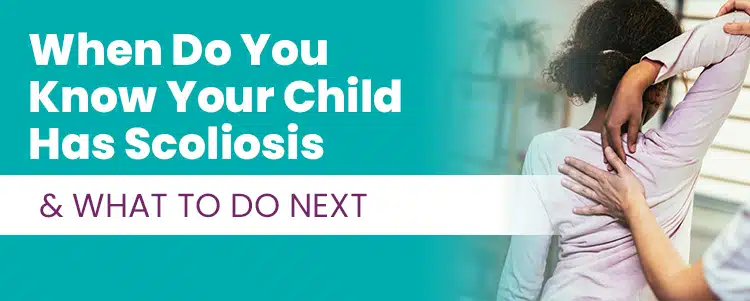While there are never treatment guarantees, early detection and intervention is associated with successful scoliosis treatment. Parents should know the condition’s early signs so they recognize when further testing is warranted.
Diagnosing scoliosis involves a physical examination and an X-ray to confirm what’s happening in and around the spine. After a diagnosis, the most important decision is how to treat it; different treatment approaches offer different potential outcomes, so be informed.
Let’s start our exploration of how to recognize the early signs of scoliosis in children, and different treatment options, by first discussing how the condition is diagnosed.
Diagnosing Scoliosis
Being diagnosed with scoliosis means an unnatural lateral (side-to-side) spinal curvature has developed, and in addition to bending unnaturally to the side, a scoliotic curve also has a rotational component, meaning it twists from back to front, front to back; the rotation is what makes scoliosis a 3-dimensional condition.
In addition, a scoliotic curve has to be of a minimum size: Cobb angle measurement of at least 10 degrees.
A patient’s Cobb angle is known as the gold standard in the diagnosis and assessment of scoliosis, and this is determined during X-ray.
When the spine’s natural and healthy curves are in place, its vertebrae (bones of the spine) are aligned as they should be, but if an unnatural curve develops, some vertebral bodies have become excessively tilted, and have shifted out of alignment with the rest of the spine.
The further out of alignment the spine is, the higher the Cobb angle will be, and in addition, the Cobb angle also classifies conditions based on severity:
- Mild scoliosis: Cobb angle measurement of between 10 and 25 degrees
- Moderate scoliosis: Cobb angle measurement of between 25 and 40 degrees
- Severe scoliosis: Cobb angle measurement of 40+ degrees
- Very-severe scoliosis: Cobb angle measurement of 80+ degrees
So as you can see, scoliosis ranges widely in severity, and this is one of the challenges behind early detection; not all cases of scoliosis cause noticeable symptoms, or at the very least, symptoms that an average person would notice.
If a parent notices some changes in their child that indicate scoliosis, the next step is going to see a doctor for a professional assessment, but before we get to what that process involves, let’s start with the types of condition indicators parents should be looking for.
How to Check for Scoliosis in a Child

When it comes to scoliosis in children, the condition isn’t always easy to identify, particularly when mild; part of the reason for this is that scoliosis doesn’t become a compressive condition until skeletal maturity has been reached.
Compression of the spine and its surrounding muscles and nerves causes the majority of condition-related pain, but the constant lengthening motion of a growing spine counteracts the compressive nature of the curve, so isn’t commonly painful for children.
While no one wants a child to experience pain, it does play the role of telling us when something is wrong inside the body, so as children don’t commonly find scoliosis painful, let’s talk about signs that are more overt.
While the symptom that brings adults in to see me for a diagnosis and treatment is pain, in children, it’s postural deviation, and this is due to the condition introducing the body to uneven forces that disrupt its overall symmetry.
Often, the condition’s earliest signs are uneven shoulders and hips, and this is why many children’s parents first notice signs of scoliosis while on vacation, or at the pool, when their child is in a bathing suit, making the back highly visible, along with any condition-related asymmetries.
In addition to uneven shoulders and hips, postural symptoms of scoliosis can include:
- A head that’s uncentered over the torso
- An uneven eye line
- Uneven shoulder blades with one protruding more on one side than the other
- The development of a rib arch
- An uneven waistline
- Arms and legs that appear to hang at different lengths
As a result of the condition’s disruption to the body’s overall symmetry, additional signs can include changes to balance, coordination, gait, and clothing that suddenly seems ill-fitting.
Scoliosis also affects all ages; babies can be born with scoliosis as congenital scoliosis, infantile scoliosis involves infants between the ages of 6 months and 3 years old, early-onset juvenile scoliosis is diagnosed in children between the ages of 3 and 10, and the condition’s most-prevalent form is adolescent idiopathic scoliosis, diagnosed between the ages of 10 and 18.
So when it comes to how to check for scoliosis in children, while having a single body asymmetry doesn’t guarantee a scoliosis diagnosis, it can indicate the need for further testing, and considering the benefits of early detection and intervention, it’s better to be overly proactive, cautious, and get early screening done.
So if a parent notices some postural changes in their child, the next step is taking them in for a professional medical screening exam; let’s talk about what that entails.
Scoliosis Screening in Children
While there was a time when mandatory scoliosis screening was performed in schools across the United States, that has since changed, shifting the onus of early detection onto the shoulders of parents, and patients themselves.
Here at the Scoliosis Reduction Center®, if a concerned parent came in with their child, I would conduct a physical examination that would involve taking the patient’s medical history, with a focus on other family members with scoliosis or other spinal conditions.
Then I would perform the standard in screening exams: the Adam’s forward bend test.
An Adam’s test involves a child standing in front of me, bending forward by hinging at the hips at a 90-degree angle, with arms dangling down at the sides.
In this position, the spine is highly visible, as are any related asymmetries, particularly in the shoulders, ribs, and hips.
When combined with the use of a Scoliometer, I can also check a patient’s angle of trunk rotation (ATR); if I notice condition indicators, the next step is an X-ray to really see what’s happening in and around the spine, and to confirm the patient’s Cobb angle to reach an official diagnosis of scoliosis.
So if your child has recently received a diagnosis of scoliosis, what should a parent do next?
What to do if Your Child has Scoliosis
Knowing what to do if your child has scoliosis is key; as a progressive condition, scoliosis has it in its nature to get worse over time, and scoliosis only gets more difficult to treat with increasing severity.
While we know that congenital scoliosis is caused by a malformed spine that develops in utero, we don’t know why the majority of idiopathic scoliosis cases develop in children, but we do know what triggers its progression: growth and development.
If a child is diagnosed with scoliosis, the most important decision to be made is how to treat it moving forward; there are two main scoliosis treatment approaches for parents to choose between, and one funnels children towards surgery, and the other provides a less-invasive non-surgical treatment option.
Traditional treatment values watching and waiting, while modern conservative treatment responds to a scoliosis diagnosis proactively, by starting treatment as close to the time of diagnosis as possible.
Here at the Scoliosis Reduction Center®, I take scoliosis in children very seriously, and this is because some ages are at risk for rapid-phase progression, due to puberty, and when detected and treated early, there are fewer limits to what can be achieved.
If scoliosis is detected in children prior to their first adolescent growth spurt, as in early-onset juvenile scoliosis, this is precisely the time to start treatment, before a significant growth spurt triggers the condition to progress, making the spine more rigid and less responsive to treatment.
In order to help patients avoid the cost and risks of spinal fusion surgery, I integrate multiple different forms of treatment so conditions can be impacted on every level.
Through a combination of condition-specific chiropractic care, physical therapy, corrective bracing, and rehabilitation, I can work towards reducing the curve size on a structural level, increasing core strength so the spine’s surrounding muscles can optimally support the spine, improving posture, and further stabilizing and healing the spine.

So if you know your child has scoliosis, what to do next is act; as a progressive condition, the best time to start scoliosis treatment, regardless of patient age and/or condition severity, is always now.
Conclusion
Although a parent doesn’t officially know their child has scoliosis until a diagnosis is given by a medical professional, there are certain condition indicators that suggest the condition’s presence; knowing these telltale signs can help lead to early detection, intervention, and treatment success.
As a progressive condition, where a scoliosis is at the time of diagnosis isn’t indicative of where it will stay, so even conditions diagnosed as mild can easily become moderate, severe, or very severe if left untreated.
The worst thing that can be done following a scoliosis diagnosis is nothing; although traditional scoliosis treatment often recommends a reactive watch-and-wait approach, the Center’s treatment results show that being proactive with treatment can be highly effective.
When it comes to scoliosis in children, the constant trigger of growth and development is a challenge, and I work towards reducing the size of a scoliotic curve on a structural level, and holding that reduction throughout growth.
When a child’s scoliosis is reduced and core strength is increased, as much of the spine’s healthy curves and function as possible have been preserved, without facing the hardships, risks, side effects, and potential complications associated with spinal fusion surgery.




